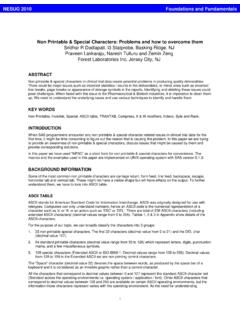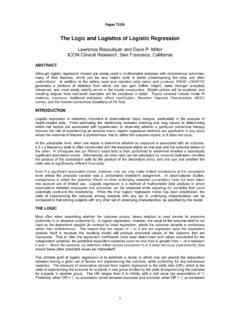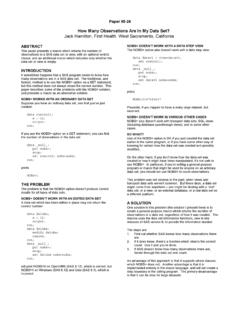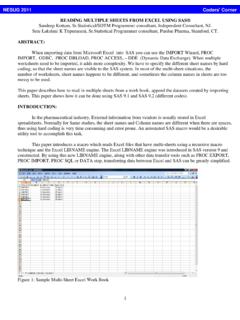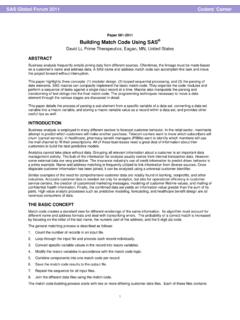Transcription of Proc Format is Our Friend - Lex Jansen
1 1 Paper TU02 PROC Format is Our Friend Erin Christen, AYW Training & Consulting, Knoxville, TN ABSTRACT For many programmers, formats are a magical wand that Data Management waves over the data to make everything pretty . With the advent of electronic-submission-ready databases and CDISC standards even this application for PROC Format has begun to fade. The average programmer uses PROC Format only to make output pretty . With the right approach PROC Format can be so much more than just cosmetic. It can make many tasks simpler, make processes more automated, make changes quicker/easier to implement and ensure consistency among programs. This paper will cover the basics of PROC Format , as well as some more advanced techniques. Best of all, the paper will provide numerous concrete examples of how PROC Format can become a programmer s best Friend . INTRODUCTION PROC Format is a much more versatile tool than it would appear at first encounter.
2 The only way to truly make full use of the tool is to have a thorough understanding of how it works and what options are available. To this end, we will first cover the most basic aspects of PROC Format . Then we will touch on some more of the advanced options and techniques. Finally, several handy uses for PROC Format will be provided. THE BASICS This section is intended for the beginner programmer (or for anybody who has shunned PROC Format up to this point). We will cover the most basic aspects of working with formats. LOCATING EXISTING FORMATS Depending on the environment and set-up in which we are working, formats may already have been made available for our use. Before we can use PROC Format most effectively, we should become familiar with the existing formats. To do this, we need to locate the Format catalog. By default, SAS looks for Format catalogs in the WORK directory and in the LIBRARY directory.
3 But, the options can also be adjusted so that SAS looks in a list of specified directories for Format catalogs instead. So we must first determine what directories SAS searches for the Format catalogs. Then we must determine whether or not Format catalogs exist in those directories. For the first step, we can use PROC OPTIONS to determine where SAS (in our environment) is looking for Format catalogs. The code is as follows: proc options group=envfiles; run; After running the code, in the LOG file, you will see a list of options and their current settings. Locate the FMTSEARCH option: FMTSEARCH=(WORK LIBRARY) This will list the libraries in which SAS searches for Format catalogs; whether or not Format catalogs exist in these libraries remains to be seen in the second step. For the second step, we need to physically check the libraries for a Format catalog. Checking can be done in more than one way.
4 One method would be to ascertain the physical path of the libraries listed in the FMTSEARCH. The following code (one of many methods) can be used to get the path: %put %sysfunc(pathname(library)); This code will print the full path associated with the libname LIBRARY to the LOG file. Then we can go to the directory and look for a file named ( and above). An alternate method to check for Format catalogs in the libraries listed in the first step would be the following code: proc contents data= directory memtype=catalog; run; This will print to the LST file a list of all the catalogs located in the specified libname (in this example the libname LIBRARY). If there is catalog called FORMATS in the output list, then there is a formats catalog in that library. 2 VIEWING EXISTING FORMATS Once we have located all existing Format catalogs, we are most likely curious to see what formats are in these catalogs.
5 The following code can be used to do that: proc Format library=<libname> fmtlib; run; *where <libname> = libname where a Format catalog exists; This code will print a map of the existing Format catalog to the LST file. A small sample might look like this: Format NAME: $SMOKE LENGTH: 14 NUMBER OF VALUES: 3 MIN LENGTH: 1 MAX LENGTH: 40 DEFAULT LENGTH 14 FUZZ: 0 .. START END LABEL (VER. V7|V8 19 DEC2005:22:31:50) 1 1 Current Smoker 2 2 Past Smoker 9 9 Never Smoked This map provides an excellent overview of the formats already available for our use.
6 Note if a Format with the same name appears in multiple catalogs, the Format from the first library listed in the FMTSEARCH option will be used. SAS FORMATS Regardless of the environment and set-up, there are also a whole host of formats provided with SAS. After digging into these, you ll find yourself amazed at what tools are already available. A complete list, along with descriptions and syntax, is available at Help, SAS Help and Documentation, Contents, SAS Products, Base SAS, SAS Language Dictionary, Dictionary of Language Elements, Formats (or Informats). USING EXISTING FORMATS/INFORMATS Using a Format is fairly simple. There are two rules to remember: (1) if we are using a Format we use the PUT() statement and using an informat we use the INPUT() statement, and (2) for character variables we must use a character Format and for numeric variables we must use a numeric Format .
7 Given a numeric variable called RACECD and a numeric Format RACEF., to use the Format to create a new variable the code would look like this: newvar=put(racecd, racef.); Similarly, for a character variable called SEXCD and a character Format $SEXF., to use the Format to create a new variable the code would look like this: newvar=put(sexcd, $sexf.); Similar code works for informats, replacing the PUT() with an INPUT(). We can also apply a Format /informat directly to a variable by using the Format /INFORMAT statement. Format racecd racef.; or Format sexcd $sexf.; The Format /INFORMAT statement can be used in a DATA step and in most PROCS. Note that PROCs always use the formatted value of the variable for the analysis process. CREATING A BASIC Format (SIMPLE) As noted, there are two types of formats, character and numeric. To create a basic numeric Format , sample code looks like this: proc Format ; value racef 1= White 2= Black 3= Asian 9= Other.
8 = Unknown ; run; *where racef is the name of the Format to be created; 3 The values on the left hand side of the equal sign are the values in the data. The values on the right hand side are the labels we want to apply to the specified value. Note, the use of the . (dot) to indicate the label for the missing values. Without this, a missing value would have been formatted to a blank value, or in the case of creating a new variable with a PUT() statement, a missing value would appear as . (dot). To create a basic character Format , the code looks like this: proc Format ; value $sexf M = Male F = Female = Unknown ; run; *where $sexf is the name of the Format to be created; Note the $ on the Format name which indicates a character Format . Note also the use of the to indicate the label for the missing values. Without this, a missing value would have been formatted to a blank value.
9 In general, any word other than SAS reserved words can be used for the name of the Format /informat. The name, however, cannot begin or end with a number. It can contain a number within the name, but it must have a character at the beginning and end. Also, By default in version 8 and later, the length of the Format /informat name can be up to 32 characters. By resetting the VALIDFMTNAME option, the Format /informat names can be forced to be 8 characters or less. To verify how long Format /informat names can be, we can check the options with the following code: proc options group=sasfiles; run; in the LOG file, the VALIDFMTNAME option indicates the current setting for Format /informat names. LONG (the default) indicates that the allowed names may be up to 32 characters long: VALIDFMTNAME=LONG or FAIL indicates that names may be up to 8 characters long, and longer names will cause the program to fail: VALIDFMTNAME=FAIL or WARN indicates that names may be up to 8 characters long, and longer names will cause a WARNING to be issued, but the program will continue: VALIDFMTNAME=WARN CREATING A BASIC Format (MULTIPLE VALUES) Beyond just a simple one-to-one mapping as illustrated above, we can also map multiple values to a single label.
10 The following code illustrates how this would work with a numeric Format : proc Format ; value phasecd 1,2,3,4,5,6,7= Treatment 8,9,10,11,12= Follow-up ; run; Now the values 1,2,3,4,5,6,7 are all mapped to Treatment ,and the values 8,9,10,11, and 12 are all mapped to Follow-up . Any other values would display as they appear in the data. We can apply a similar method for a character Format : proc Format ; value $phasecd W1 , W2 , W3 , W4 , W5 , W6 , W7 , W8 = Treatment W12 , W16 , W20 , W24 = Follow-up ; run; Now values W1, W2, W3, W4, W5, W6, W7 and W8 are all mapped to Treatment , and values W12, W16, W20 and W24 are all mapped to Follow-up . CREATING A BASIC Format (NUMERIC RANGES) In addition, we can use ranges and lists of values to create formats. For example, we can apply a single label to ranges of values with code like this: 4 proc Format ; value abnlab 0 - < 9 = OK 9 12 = WATCH 12 < - <25 = ALERT 25 100 = EMERGENCY ; run; The number on the left hand of the hyphen is the bottom of the range.






